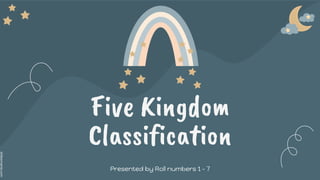
Five kingdoms of classification
- 1. slidesmania.com Five Kingdom Classification Presented by Roll numbers 1 - 7
- 2. slidesmania.com Today’s Agenda ! Introduction to our topic Category levels of diversity Binomial nomenclature Drawbacks of the old two kingdom classification
- 3. slidesmania.com Introduction Millions of living things inhabit our planet, they are divided into five kingdoms: Animal, Plant, Fungi, Protist and Monera. Robert Harding Whittaker was an American plant ecologist, He was the first to propose the five kingdom taxonomic classification of the world's biota into the Animalia, Plantae, Fungi, Protista, and Monera in 1969. ROBERT HARDING WHITTAKER
- 4. slidesmania.com Category Levels of Diversity
- 5. slidesmania.com Species Species means an organism of a particular kind whose members can interbreed among themselves to produce fertile young ones. All individuals of a species can normally breed among themselves. Individuals of a particular species differ from all other living beings. 01
- 6. slidesmania.com Genus Similar species constitute the next higher category of genus. Genus, plural genera, is the biological classification ranking between family and species, consisting of structurally or phylogenetically related species or a single isolated species exhibiting unusual differentiation (monotypic genus). 02
- 7. slidesmania.com Family Family (Latin: Familia, Plural: Familiae) is one of the eight major hierarchical taxonomic ranks in Linnaean taxonomy. A group of genera with certain common characteristics form a family. It is classified between order and genus. A family may be divided into subfamilies, which are intermediate ranks between the ranks of family and genus. A family is the collection of similar genera. 03
- 8. slidesmania.com Order Order is a taxonomic rank used in classifying organisms, generally below the class, and comprised of families sharing a set of similar nature or character. It is a succession or sequence, usually arranged in a series. Order is a group of related families. One example of order is, “Carnivora”. 04
- 9. slidesmania.com Class A class is the taxonomic rank in the scientific classification of organisms in biology below phylum and above order. For example, Mammalia is the class used in the classification of dogs, whose phylum is Chordata (animals with notochords) and order is Carnivora (mammals that eat meat). 05
- 11. slidesmania.com Kingdom The kingdom is he largest division of human being. When Carl Linnaeus introduced the rank-based system of nomenclature into biology in 1735, the highest rank was given the name "kingdom" and was followed by four other main ranks: class, order, genus and species. Later two further main ranks were introduced, making the sequence kingdom, phylum, class, order, family, genus and species. In 1990, the rank of domain was introduced above kingdom. So the five kingdoms under the recent scheme of classification are 1. Monera 2. Protista 3.Fungi 4.Plantae and 5.Animalia 07
- 13. slidesmania.com Binomial Nomenclature Binomial Nomenclature was given by Carolus Linnaeus (1707 - 1778). In this system, each name has two components - generic name and specific epithet. For example, binomial name for Mango is Mangifera Indica where 'Mangifera' denotes generic name ( genus ) and 'indica' represents specific epithet ( species ). This method of naming the organisms is called Binomial Nomenclature.
- 14. slidesmania.com Drawbacks of the old two kingdom classification
- 15. slidesmania.com Drawbacks According to the old classification the world of organisms was divided in two groups : Plantae and Animalia. This scheme had several drawbacks : Bacteria cannot be called plants because they are prokaryotic organisms, and some possess flagella to help them move. Some single celled organisms such as Euglena cannot be exclusively called plant or animal as they have chloroplasts like plants and, cell- mouth to feed like animals Fungi are also not plants as they neither have chlorophyll nor roots, stem or leaves.
- 16. slidesmania.com THANK YOU! Presented by Roll numbers 1 - 7
- 17. slidesmania.com Credits. Avi Goyal Hrishita Patil Jiiya Vakharia Kashvi Savla Krisha Parekh Leisha Jain Nyari Gandhi
Editor's Notes
- Hrishita
- Leisha
- Leisha
- Krisha
- Nyari
- Jiiya
- Avi
- Jiiya
- Kashvi
- Hrishita